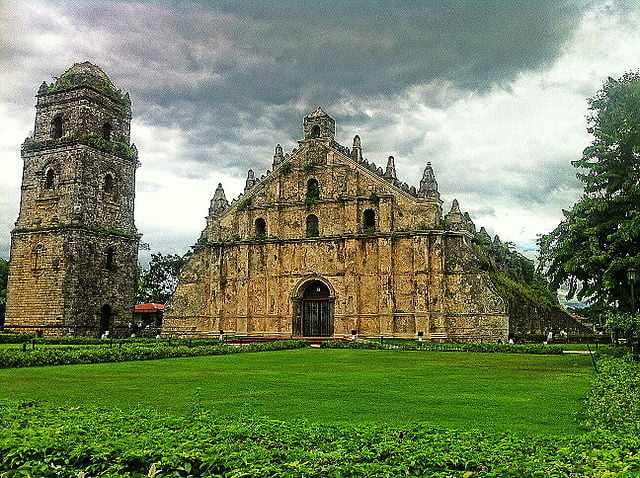Luzon, the Philippines’ largest island, is known for its pristine beaches, stunning landscapes, rich history, and vibrant culture. One of the best ways to explore the island’s cultural heritage is by visiting the oldest churches of Luzon. These churches showcase impressive architectural designs and serve as a testament to the country’s deep-rooted Catholic faith.
From the grandeur of the Baroque-style churches to the simplicity of the stone-walled structures, Luzon has an abundance of historic churches that are worth a visit. So, whether you’re a devout Catholic or a history buff, join us as we journey through the oldest churches in Luzon that you should add to your bucket list. Get ready to be awed by these magnificent churches’ beauty, grandeur, and rich history.
Tours and activities: Reserve now and pay later.
Oldest Churches in Luzon: San Agustin Church (Intramuros, Manila)

San Agustin Church is the Philippines’ oldest stone church. You can find it on the southern wall of Intramuros. Though constructed using bamboo and nipa leaves in 1571, the church’s rebuilding used adobe stone in 1607.
The church’s construction began in 1587 under the supervision of Augustinian Fathers Francisco de Bustos, Ildefonso Perez, Diego de Avila, and Brother Alonso de Perea. The church has survived multiple earthquakes and other disasters and was declared a World Heritage Site by UNESCO in 1993. It is the only church dating back to the Spanish Colonial Era in the walled city.
Trip.com Up to 50% off on flights to Asia!(ENG)
Quipayo Church (Calabanga, Camarines Sur)

Quipayo is one of the oldest churches in the Philippines, established in 1578 by Franciscan Missionaries Fr. Pablo de Jesus and Fr. Bartolome Ruiz. It is a significant structure built during the Spanish Regime in the region and stands as an enduring symbol of Catholicism in Bicol. Our Lady of the Immaculate Concepcion is the patroness of Quipayo, and the church services the parishes of Ligmanan (Libmanan), Baigon (Siruma), Calabangan (Calabanga), and Bombon.
A museum behind the church altar also displays some artifacts excavated at the church’s site. Finally, it was declared a National Historical Landmark by Presidential Decree No. 260, dated August 1, 1973, and amended by Presidential Decree No. 1505, dated June 11, 1978.
Oldest Churches in Luzon: Majayjay Church (Majayjay, Laguna)

The original structure of the Romanesque church of Majayjay had plywood, which didn’t last long. The present version of the church is quite impressive, measuring 200 feet in length, 56 feet in width, and 54 feet in height. The façade is an eye-catching feature of the church, with three levels proportionally scaled and a triangular pediment with a circular window on the highest level.
The church’s central nave comprises the leading portal’s substantial wooden door, choir loft windows, and a saint’s niche. Its interior boasts a retablo mayor and four minor retablos with intricate designs. The church’s floor used azulejo, a glazed, colored Spanish tile.
The five-story square bell tower with a conical roof and balustrade windows on each level connected to a langit-langitan catwalk. It is above the ceiling, leading to the transept crossing. Another exciting feature is the belfry, which has arched windows decorated with a bell trimmed with finials and a large antique bell.
Considered one of the Philippines’ oldest churches, the Majayjay Church has antique images of saints, shrines, and century-old liturgical objects.
Pililla Church (Pililla, Rizal)

The arrival of the first missionary priests in Pililla dates back to 1572. The Franciscan priests ordered the construction of a church in the area, and the locals managed to build one using bamboo and cogon in 1583. Later on, a structure made of palm trees was erected from 1670 to 1673 before the current stone structure took its place. Pililla Church is the fourth oldest church in the Philippines.
The church underwent renovations in 1848, including the altar and convent. Another round of renovations took place from 1962 to 1972. The current structure is adobe, the same material used in other Philippine churches. The church’s dedication to St. Mary Magdalene is evident with the building a small retablo to house the saint’s image inside the baptistery.
Oldest Churches in Luzon: Baras Church (Baras, Rizal)

The church in Baras has a rich history dating back to 1595, when the Franciscans originally built it. Unfortunately, the Aetas burned it down during their rebellion, resulting in the town’s transfer to Ibayo in 1636. However, the city returned to its current location in 1682. The Jesuits managed the parish from 1616 to 1679. However, the church’s present state had been existing since 1686.
The Baras Church displays a Baroque style, evident in its simple and dark layout. The front facade is relatively plain, except for the balustrade stream, which trims the triangular pediment, and the brick and stone checkerboard pattern on its upper portion.
When you step inside the church, you’ll notice the exposed wooden trusses, which support the roofing, and there is no decorative ceiling as is common in churches in the area. Instead, the adobe bricks used to build the church are visible, giving churchgoers a glimpse of what people from centuries ago would have seen.
Paoay Church (Paoay, Ilocos Norte)

The restoration of the St. Augustine Church, also known as the Paoay Church, started in 1894. Its unique blend of Gothic and oriental designs has earned it the nickname “Earthquake Baroque.” Its facade displays a Gothic style and incorporates Chinese and Javanese elements in the roofs and niches on the walls.
The area has a rich history beginning in 1593. Moreover, it became an independent Augustinian parish in 1686. The current church’s construction started in 1694 under the guidance of Father Antonio Estavillo. Building the church finished in 1710, and its restoration in 1896.
Oldest Churches in Luzon: Betis Church (Guagua, Pampanga)

The Baroque style heavily influenced the Betis Church, constructed in 1660. It is famous for its splendid European murals and carvings, making it one of the most stunning churches today. Betis was an independent city with municipal autonomy during the Spanish colonial era.
Macario Ligon’s original frescoes and trompe l’oeill artwork adorn the interior. Anac Baculud, a protégé of Dr. Sijuco, and a relative of Juan Crisostomo Soto, Isidoro C. Soto, painted the ceiling. Doro Soto, the nickname of Isidoro, painstakingly created the artwork on the ceiling.
Check the cheapest flights below if you’re going anywhere in the Philippines.
Final Thoughts
If you plan a trip to the Philippines’ principal island, there’s more to explore than just booking tour packages or attending festivals in Luzon. The major island group is also home to several notable churches that offer a glimpse into its rich history and culture. Whether you want to take pilgrimage tours or appreciate the beauty of these churches, this list of beautiful churches in Luzon can be an excellent resource for you. Save it for a complete experience of all the Philippines offers.

Pingback: Oldest Churches in the Visayas You'll Like to Visit - Hop 'N Cruise